Here are 10 things you should know about John Boles, born 126 years ago today. The tall, dark and handsome star’s career thrived in the 1930s but slowed down thereafter.
Tag: Shirley Temple
Remembering Gloria Stuart on Her Birthday
Gloria Stuart was born on Independence Day, 1910, in Santa Monica, California. In 1999, when she was just a kid of 89, we got to interview her on the occasion of the publication of her memoir, I Just Kept Hoping. The interview was conducted over the telephone, though we did get the chance to meet Ms. Stuart when she came to NYC for her book party.
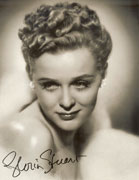
We considered it quite a thrill, we don’t mind telling you, to get to interact with Ms. Stuart. After all, this is the women who starred opposite Claude Rains in James Whale‘s The Invisible Man, who appeared with Boris Karloff, Melvyn Douglas, and Charles Laughton in The Old Dark House, who worked with greats such as Irene Dunne, Ralph Bellamy, Pat O’Brien, Lionel Barrymore, Lee Tracy, Nancy Carroll, Frank Morgan, Paul Lukas, Edward Arnold, Eddie Cantor, Ruth Etting, and dozens more.
So, to celebrate her 111th birthday, we thought we’d share the interview we did with her in 1999. Enjoy!
It’s been a long, eventful life for former and current movie star Gloria Stuart. She had her first go-around at stardom in the Hollywood heyday of the 1930s and ’40s; then, after taking off 30 years or so to pursue painting, travel, and political activism, she again began to act in the 1970s, eventually garnering a Best Supporting Actress nomination for her role in Titanic. Still going strong today at the age of 89, Stuart has now added authorship to her list of achievements. Her candid memoir, I Just Kept Hoping, is peppered with anecdotes about such memorable figures as Shirley Temple, Groucho Marx, Dorothy Parker, and J. Robert Oppenheimer, the father of the atomic bomb. We spoke to Gloria about her life, her two careers in the movies, and her secrets for living so long and so well.
An Interview with Gloria Stuart
You made three films with director James Whale: The Invisible Man, The Old Dark House, and The Kiss Before the Mirror. What can you tell us about him?
I’m very happy I was in those films. You know, James is a cult figure in England. There are a lot of James Whale fan clubs. Actually, right after I had read for Jim Cameron for Titanic, I had booked a month in London. I went right away, and there were two wonderful James Whale organizations that I met with. He’s getting his due now, thanks to Gods and Monsters.
What did you think of Gods and Monsters? Was it, in your view, an accurate portrayal of Whale?
Oh, yes, it was. Ian McKellan captured James’s elegance, the beautiful manners, the beautiful tailoring, the precision, the whole thing. Of course, no one could be James, but he came awfully close.
The special effects in The Invisible Man hold up remarkably well today for a film that was made in 1933.
Yes, people who see it today—it runs every so often—they say, gee, it’s not an old hat movie at all.
I’m wondering—did the processes that went into creating those special effects slow down the pace of moviemaking at all?
It was never evident. Only James and the cameraman and I guess all the process people at Universal—the rest of us never had any inkling of what was going on. We did do a lot of shooting in front of black curtains. Now, I wasn’t on the set when the bandages came off or anything like that, so I have no idea about that. But it was very, very secret. I wasn’t on the set when they were finagling the bandages off, and so forth.
That would’ve been fun to see.
Yes, it would’ve! Claude [Rains] may have known [how it all worked] but he never said so.
You and your second husband, Arthur Sheekman, were good friends with Humphrey Bogart and Mayo Methot, his wife at the time. What can you tell us about Bogie that we might not know?
Read More »
Happy 112th Birthday, Kay Francis!
Fashion plate and Queen of the Women’s Pictures Kay Francis was born Katherine Edwina Gibbs 112 years ago today in Oklahoma City, Oklahoma. Here are 10 KF Did-You-Knows:
- Though Francis was born in Oklahoma City, she didn’t live there long. Much of her childhood was spent on the road with her mother, Katherine Clinton, who was an actress. At age 17, Francis, who was then attending Katherine Gibbs Secretarial School in New York City, married the first of her five husbands—one James Dwight Francis, member of a prominent (and well-to-do) Pittsfield, Massachusetts, family. That marriage, like the four other matrimonial knots Francis would eventually tie, unraveled in relatively short order.
- Shortly after her 1925 divorce, Francis decided to follow her mother’s example and pursue a life on the stage. In November of that year, she made her Broadway debut as the Player Queen in a modern-dress version of Shakespeare’s Hamlet.
- After a handful more Broadway roles, Walter Huston, her costar in the 1928 production of Elmer the Great, encouraged her to take a screen test for Paramount Pictures. She did, and was given roles in Gentlemen of the Press (1929) and the Marx Brothers‘ first picture, The Cocoanuts (1929), both of which were filmed at Paramount’s Astoria Studios in Queens, NY.
- Soon thereafter, Francis moved to Hollywood where her striking looks and model’s figure (she stood 5’9″, very tall for an actress at the time) helped her career to ascend. From 1929 to 1931, she appeared in more than twenty films.
- Warner Brothers wooed Francis away from Paramount in 1932, and it was there that she experienced her greatest success. By the mid-’30s, Francis was the queen of the Warner Brothers lot and one of the highest-paid people in the United States. From 1930-37, Francis appeared on the cover of more than 38 movie magazines, second only to Shirley Temple (who racked an astonishing 138 covers over that span).
- At Warner Brothers, Kay became known as a clotheshorse. Her ability to wear stylish clothes well was highly valued by the studio and admired by fans; in fact, she eventually came to feel that Warner Brothers put more more of a focus on her on-screen wardrobe than her film’s scripts, as she came to be unalterably associated with the sort of weepy melodramas that were then known as “women’s pictures.” We fully understand the frustration she felt at the time, but we’ll admit that we love those pictures and adore Francis’ performances in them.
- Francis’ great success came in spite of a noticable speech impediment: She pronounced R’s as W’s (ala Elmer Fudd). As such, our favorite line of Kay Francis dialogue appears in Mandalay (1934), which was directed by Michael Curtiz and in which Kay starred with Ricardo Cortez, Lyle Talbot, and Warner Oland. It’s great fun to hear her intone, “Gwegowy, we awwive at Mandalay tomowwow.”
- Francis’ personal life was something of a mess. An exceedingly liberated person, sexually, she slept with both men and with women—and plenty of them, and none of her five marriages lasted very long.
- Francis’s career fell as quickly as it had risen. She was through with the movies (or perhaps vice versa) by 1946, when she appeared in her final picture, Wife Wanted, a budget quickie made for the infamous Poverty Row studio Monogram Pictures. Aside from some stage work in the late ’40s and a couple of TV appearences in the early ’50s, she avoided the spotlight thereafter and was largely forgotten by the public (until Turner Classic Movies began to feature her pictures prominently in its programming and her star again rose among old-movie buffs).
- When she died in 1968 of breast cancer, Kay Francis left more than one million dollars to The Seeing Eye, Inc., an organization that trains guide dogs for the blind.
Happy birthday, Kay Francis, wherever you may be!
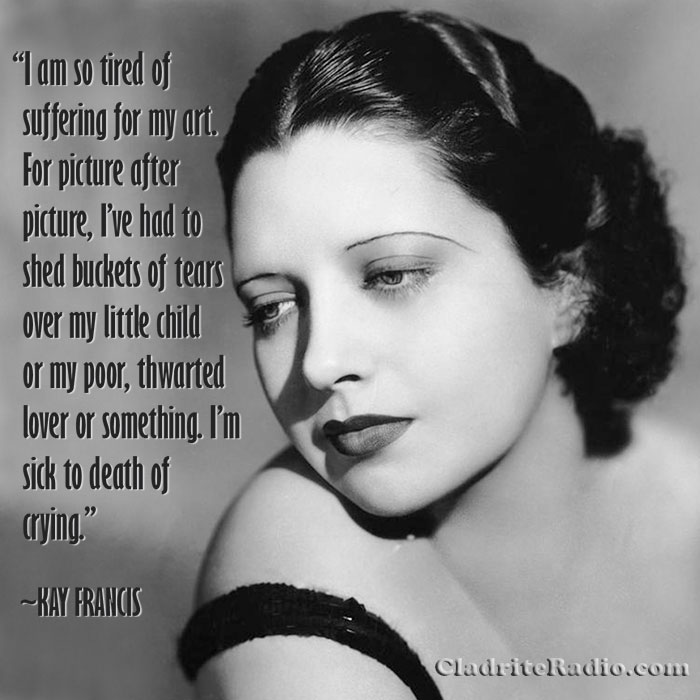
Dickie Moore Takes His Final Bow
Some years ago, we were lucky enough to attend a special event at NYC’s Film Forum: A Q&A with actors Jane Powell and her husband, Dickie Moore (he went by Dick in his post-Hollywood professional life, but we’ll always think of him as Dickie).
Powell, of course, achieved renown for her work in musicals for MGM, while Moore … well, Moore’s career is not so easily characterized. He started working at the age of 11 months in a 1927 silent picture called Our Beloved Rogue opposite John Barrymore, and he was featured in the Our Gang series in 1932–1933.
He also had the distinct honor of planting her first on-screen smooch on Shirley Temple in a feature called Miss Annie Rooney (1942). And at the age of 21, he played a deaf-mute young man opposite Robert Mitchum in one of the greatest of films noir, Out of the Past.
It was a delight to see these two Hollywood veterans in tandem that night. They couldn’t have been more charming, and their mutual respect and affection was readily apparent—in short, they were darned cute together—as they delighted those assembled with insider tales of Hollywood’s glory days.
So it with sadness that we share news of Mr. Moore’s passing on Thursday, just two days short of his 90th birthday.
Dickie Moore was perhaps the busiest of child actors (we can’t think of a more prolific one), and he acted opposite the greatest names of Hollywood’s Golden Age, including Warren William, Mary Astor, Ginger Rogers, Lionel Barrymore, Mae Clarke, Ann Harding, Spencer Tracy, Loretta Young, Glenda Farrell, Kay Francis, Barbara Stanwyck and so many more.
In his memoir, Twinkle Twinkle, Little Star, Dickie Moore bemoaned the struggles that so many child actors experience not only when they’re working steadily, but also as they grow older and their careers wane. We dearly hope and trust that Moore’s own post-Hollywood path was a bit smoother and that he experienced no regrets about his years in Hollywood. He certainly gave movie buffs from the 1930s through today much to be thankful for.
Rest in peace, Mr. Moore, and thanks.
Goodbye to another glorious gal
The lovely and talented Hideko Takamine passed away last week at the age of 86. She worked with such well-regarded directors as Akira Kurosawa and Yasujiro Ozu, but she is best remembered for the work she did with another of our favorite directors, Mikio Naruse.
We were saddened to learn of her passing. We had always intended to send her a fan letter (though a response would not likely have been forthcomng), and we regret not having done so.
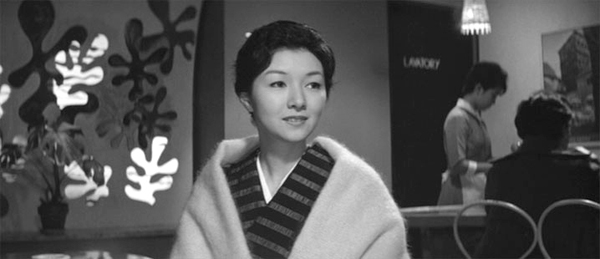
If you’re not familiar with her work, some of it is available on DVD. Criterion has two of her pictures in their catalog — When a Woman Ascends the Stairs (directed by the aforementioned Naruse) and Twenty-Four Eyes, directed by Keisuke Kinoshita.
Some years ago, NYC’s Film Forum held a four-week retrospective featuring 31 of Naruse’s pictures. We approached the festival’s first film with low expectations, simply because we knew nothing of Naruse’s work, though we have an affinity and affection for classic Japanese cinema.
We were immediately won over, however, and ended up attending all but one of the 31 screenings. We found Naruse’s elegant tales of average people struggling to get by both moving and heartening. Naruse was a man who saw the sadness in the world and wasn’t afraid to depict it, but there’s a resolve in his work and in his characters that is also hopeful.
In immersing ourselves in Naruse’s oeuvre, we gained an appreciation for many of the actors who made repeat appearances in his pictures, and it was Ms. Takamine, along with Setsuko Hara and Kinuyo Tanaka, who most impressed us. Takemine appeared in at least twelve of Naruse’s films over the years, generally portraying, as Ron Holloway once wrote, “one from the underprivileged classes and usually a tragic figure who endures despite the whims of fate.”
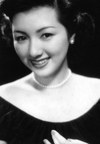 |
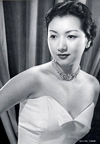 |
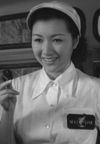 |
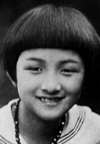 |
 |
 |
Takamine’s first screen appearance came in 1929 at age 5, and she continued working until 1979, certainly a impressive and admirable run for any actor. She was a beloved figure in Japan, leading some to compare her status there to that of Mary Pickford in the United States, but others have suggested that Katherine Hepburn is a better comparison, given that Ms. Takamine proved to be just as self-sufficient and independent in her handling of her career and personal life as the plucky and iconic Hepburn. She first defied convention by eschewing a studio contract and going independent in 1950 and then, after she married screenwriter Zenzo Matsuyama in 1955, she followed her own path by, as Dave Kehr wrote in his New York Times obit of the actress, “continuing to work as an actress rather than withdraw into domestic life.”
Shirley Temple might also be a worthy comparison, given Ms. Takamine’s popularity as a child star in Japan.
Ms. Takemine, who also authored a number of published essays and books, led a more private life upon retiring. She and Matsuyama divided their time between Tokyo, where she no doubt was recognized everywhere she went, and Hawai’i, where she enjoyed a bit more anonymity.
A marvelous actress, gone but not forgotten.

